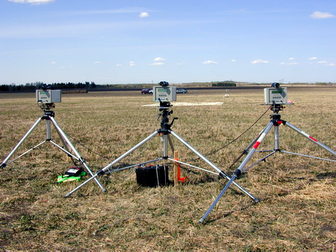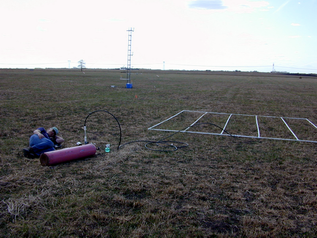
Gas dispersion trials, Ellerslie 2001
Objective
We wished to determine the accuracy with which we could estimate the rate of emission (Q) of methane from the artificial source (the white PVC frame, from which gas was released from fine holes), from a measurement of the line-averaged (15 minute mean) methane concentration as detected by a nearby infra-red laser. This was in order to test - on ideal, flat terrain and with a simple, known source - the performance of the "backward Lagrangian stochastic" (bLS) technique, which using measured wind statistics computes particle paths from the source to the detector and provides an estimate QbLS of the (here independently known) emission rate Q.
The 6 m tower seen against the horizon supported anemometers and thermometers to determine the statistical "state" of the atmospheric surface layer, ie. friction velocity u*, Obukhov length L, surface roughness length z0, and mean wind direction b. The mean value of the ratio QbLS/Q over 77 trials was 1.02 (Flesch et al., 2004).

Acknowledgements
Research funding was provided by the Natural Sciences and Engineering Research Council of Canada (NSERC) and the Canadian Foundation for Climate and Atmospheric Sciences (CFCAS).
Back to the Earth & Atmospheric Sciences home page.
Last Modified: 15 Sept. 2005


